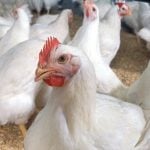Anyone who knows me knows that I go on and on – tiresomely and incessantly – with my wondering about the question: Are we re-living the 1970s or 1930s?
It’s a question of vital importance for farmers, because the 1970s made lots of farmers (temporarily) rich, and the 1930s did the opposite. So whether we’re in an inflationary period (1970s) or deflationary period (1930s) will have a major impact on farmers – and already has.
Right now it’s still looking more like the 1970s than 1930s – with high crop prices and a rising commodity complex and a still-surviving economy – but I think it’s far too early to rule out a deflationary future. Anyhow, with these musings in mind, I thought I’d bring you some thoughts from two analysts I’ve recently read and heard who are taking opposite views on this question. The first is more narrowly focused to the next year or two – and to one industry – and the second is a very broad outlooker.
Read Also

Growth plates are instrumental in shaping a horse’s life
Young horse training plans and workloads must match their skeletal development. Failing to plan around growth plates can create lifelong physical problems.
Then you can muse about the question yourself.
Christopher Growe, food manufacturer analyst with Stifel Nicolaus:
(From an interview on Bloomberg radio with Tom Keene and Ken Prewitt)
“We estimate an abrupt shift to price realization in the second half (of 2011),” Growe wrote in a recent research report. He said in the radio interview that this means that food manufacturers will “move rather quickly – more quickly than you normally expect in this kind of an environment – to a period of price increases.”
Why is that? Growe said the period of deflation last year is over, and food manufacturers – after slashing prices through promotions last year – will move the other way this year because of a recovering economy and because “input” prices keep rising. He expects five to seven percent input inflation in 2011 and the same in 2012. A big part of that is corn, wheat and other crop prices.
That makes this calendar year look a lot like 2008 – that historic commodity price spike.
“2008 was much like what we are seeing right now. 2008 was a period of intense cost inflation across almost every input that I track, from energy to packaging to wheat and corn. I would say we’re looking a lot more like 2008 right now. It’s not quite as bad yet, but it very well could be.”
When he says “bad,” he means from the perspective of investors in General Mills, Kraft, Kellogg, etc. From the crop farmer’s perspective, that word should be converted to “good.” So growers should be hoping for a whole bunch more badness in 2011, and Growe expects to see it through the year and into next year.
Let inflation reign!!
Robert Prechter, Elliott Wave International:
Prechter – the prime proponent of Elliott Wave theory, a complex form of technical analysis – thinks the commodity price rally is ready to have a fork stuck in its butt to turn it over: it’s done:
“Completed Upward Correction in the CRB Commodity Index” is his headline partway through the January Elliott Wave Theorist newsletter he writes, arguing the rise in commodity prices has hit a likely retracement level coming out of the 2009 low, and now prices are likely to turn downwards again:
“Just as with the major stock averages, the CRB index of commodity prices traced out five waves down from its all time high, which occurred in July 2008. Its collapse wiped out 57 percent of its value in eight months. As with stocks, the five-wave structure of the decline defines the longer term trend as down. Now the CRB index has reached the upper end of its corrective-wave trend channel while simultaneously reaching a Fibonacci 50 percent (1/2) retracement of the 2008-09 decline, as it completes an A-B-C rally. This index should soon begin another wave down that takes it below the 2009 low. See figure 9.”
If that explanation was a touch too complicated for you, here’s the chart that ran with that section of the report:
 So, there you have it: two differing views on whether we’re in an inflationary or deflationary environment, and what that will mean for commodity prices. Growe expects continuing strength in most commodities – like the first half of 2008 – for 2011 and 2012. Prechter expects the recent rally to be just a correction in a continuing deflationary slump and that it’s already reached a likely reversal point.
So, there you have it: two differing views on whether we’re in an inflationary or deflationary environment, and what that will mean for commodity prices. Growe expects continuing strength in most commodities – like the first half of 2008 – for 2011 and 2012. Prechter expects the recent rally to be just a correction in a continuing deflationary slump and that it’s already reached a likely reversal point.
If I had to make a guess at answering my own question, I’d suggest early 2011 looks a lot like early 2008, and that history tends to make reverberations and have echoes, and we’re in the middle of a 2008y echo right now, so it’s probably a bit early to expect a reversal. This looks to me a lot like the 1972-74 period of one huge spike followed by a large but smaller spike. But whether a concomitant collapse is coming after that, and whether or not that will push us beyond inflationary pain into deflationary collapse – is still too early to tell.
So I’m still copping-out on the central commodity question that has occupied my thoughts since 2008. But I’m keenly gathering others’ views on the question and will keep bringing them to you, as I did above. I’ll let you know if I ever make my own mind up.















